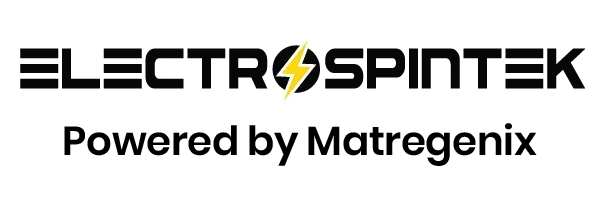In the fast-evolving world of advanced materials, the nanofiber electrospinning unit has become a cornerstone for industries aiming to produce high-performance fibers with unmatched precision. At Electrospintek, we believe that innovation lies not just in discovery but in how technology is scaled and applied. Electrospinning has matured from a niche laboratory technique into a robust industrial tool, and its influence on manufacturing is only growing.
The Backbone of Nanofiber Manufacturing
The nanofiber manufacturing process relies heavily on precision, consistency, and scalability. Traditional fiber production methods struggle when fibers need to be thinner than a human hair, often in the nanometer range. That’s where the nanofiber electrospinning unit shines.
By applying a high-voltage electric field to a polymer solution or melt. Electrospinning creates ultra-fine fibers that are collected into mats or layers. The result is a structure that offers unique properties lightweight, porous, and incredibly strong. This process is essential for industries ranging from healthcare to aerospace, where performance depends on microscopic precision.
Electrospinning Technology Benefits for Industry
The electrospinning technology benefits are diverse and far-reaching. One of the most significant advantages is the ability to tailor fibers at the nanoscale, offering manufacturers an opportunity to create products that outperform conventional materials.
Some key benefits include:
- Superior filtration capabilities: Ideal for air and water purification.
- Enhanced mechanical properties: Strong yet flexible materials.
- Customizable functionality: Additives, coatings, or blends to achieve specific results.
- Sustainability: Reduced raw material usage compared to bulkier methods.
For industries chasing innovation, these benefits mean improved performance and reduced production costs over time.
Moving from Lab to Large-Scale
Historically, electrospinning was confined to research labs because of limited output. Scaling this delicate process was challenging. However, today’s nanofiber electrospinning units are designed with large-scale manufacturing in mind.
Modern industrial setups incorporate multiple nozzles, automated controls, and advanced collection systems. This ensures continuous, high-throughput fiber production without sacrificing quality. By integrating automation, manufacturers can run 24/7 operations, bringing nanofibers out of the lab and into everyday products like medical masks, energy storage devices, and protective clothing.
Industrial Electrospinning Applications
Electrospintek has seen firsthand how industrial electrospinning applications are revolutionizing different sectors. Let’s look at a few notable examples:
- Healthcare: Wound dressings, drug delivery systems, and tissue engineering scaffolds benefit from the unique structure of nanofibers.
- Filtration: Air filters, water membranes, and even oil separation units rely on nanofibers for exceptional efficiency.
- Energy: Batteries and supercapacitors are enhanced with nanofiber components that improve conductivity and storage capacity.
- Textiles: Lightweight, breathable, and protective fabrics find use in sportswear and military gear.
By offering solutions across such diverse industries, nanofiber electrospinning proves its versatility and impact.
Ensuring Nanofiber Quality Control
One of the biggest hurdles in advanced manufacturing is maintaining consistent product standards. With fibers at the nanoscale, even small deviations can cause defects. That’s why nanofiber quality control is integral to every electrospinning setup.
Electrospintek’s units are equipped with real-time monitoring systems that track fiber diameter, distribution, and uniformity. Automated adjustments ensure the production line remains stable, even under high-output conditions. This precision is what allows industries to confidently rely on nanofibers for critical applications, from medical devices to aerospace engineering.
Electrospinning Units and Productivity Gains
A well-designed nanofiber electrospinning unit doesn’t just create fibers it optimizes productivity. Here’s how it improves production:
- Automation: Reduces manual labor, minimizing errors.
- Scalability: Expands from pilot projects to full-scale industrial runs seamlessly.
- Energy efficiency: Modern systems consume less power compared to traditional alternatives.
- Customization: Manufacturers can quickly adapt setups for different polymers or blends.
This combination of flexibility and efficiency means companies can respond faster to market demands without compromising quality.
Why Electrospintek Leads in Electrospinning
At Electrospintek, our mission is to push the boundaries of what’s possible with nanofibers. We design electrospinning systems that are not only technically advanced but also user-friendly. Our clients from startups to global manufacturers trust us because we deliver solutions tailored to their unique production needs.
Our focus on innovation ensures that every nanofiber electrospinning unit is built to meet the challenges of modern manufacturing. Whether it’s achieving tighter tolerances, reducing downtime, or enhancing throughput, we ensure our technology drives measurable results.
The Future of Electrospinning for Large-Scale Manufacturing
Looking ahead, the future of electrospinning for large-scale manufacturing is bright. As industries demand greener, stronger, and smarter materials, nanofibers will become even more indispensable. With improvements in AI-driven monitoring, hybrid material processing, and sustainable raw materials, the electrospinning process is set to become faster, cleaner, and more cost-effective.
Electrospintek is proud to be at the forefront of this transformation. By bridging the gap between research and industry, we help businesses unlock the full potential of nanofibers.
Final Thoughts
The nanofiber electrospinning unit is more than just a machine it’s a catalyst for industrial progress. From improving efficiency to ensuring impeccable quality control. These units are redefining the way advanced materials are made. For companies seeking innovation, scalability, and reliability, electrospinning is no longer optional it’s essential.
At Electrospintek, we’re not just keeping pace with this change we’re driving it. The question isn’t whether your industry can use nanofibers, but how quickly you can integrate them into your production line. With the right partner and the right technology, the future of manufacturing is already here.
